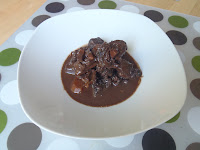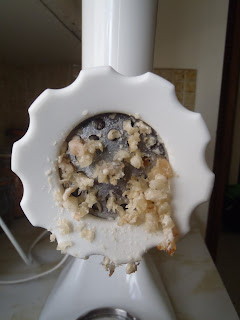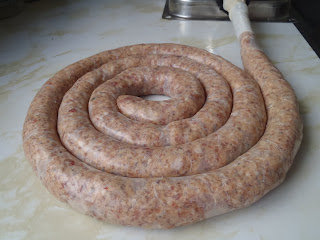skip to main |
skip to sidebar
 This cake is based on a recipe from Fergus Henderson's book The Whole Beast. The procedure and recipe are almost identical to those for blood sausage:
This cake is based on a recipe from Fergus Henderson's book The Whole Beast. The procedure and recipe are almost identical to those for blood sausage:
- sweat onions, garlic, and spices in butter;
- add blood and heat to thicken;
- add cornmeal in a steady stream, stirring constantly to prevent clumping;
- heat the mixture until it thickens;
- add diced backfat;
the only difference being that the mixture is cooked in a loaf pan in a water bath instead of casings.
Unlike the first round of blood sausage, this cake set beautifully. It was tender, but held up to slicing. This experiment reinforces my theory that there was too much moisture in the other blood sausages. (The cornmeal in the cake was cooked directly in the blood, while the oats in the blood sausage were cooked in water first.) Henderson's recipe would make a fantastic stuffing for blood sausage. Maybe a polenta, fennel, and chili blood sausage...
Happy Halloween.

The main event as far as cooking with blood is blood sausage.
Blood sausage is, as I have written before, pretty much what you would expect: pig's blood and fat, seasoned and stuffed into casings. The sausages are almost always flavoured with onions, and often contain a starch like oats or cornmeal or rice.
I have only come across blood sausage twice in Edmonton. My first taste was at Charcutaria Micaelense, but they have since stopped making their own and instead carry an inferior commercial substitute. More recently I have tried the blood sausage at Old Country Meats.
There are a few reasons we don't see it very often here. First: our timorous approach to eating. Second (and closely related to the first...): the hassle of obtaining pig's blood. I started asking at farmers' markets, only to find that the farmers themselves couldn't acquire their animals' blood from the abattoirs. Apparently health inspectors are worried about the wholesomeness of the blood after transport. Blood certainly needs to be used while very fresh; if left in the fridge for, say, a week, it will coagulate and develop the same sour odour as wet-aged meat. To my mind, this is a food quality issue, and not at all a food safety issue. Blood deteriorates rapidly, but that doesn't mean it's dangerous to sell or consume.
It's unfortunate that we don't cook with blood more often, as pigs are always bled after being stunned, and harvesting the blood is simply a matter of putting a bucket beneath the hanging animal, instead of letting it drip into the bleeding pit.
Kevin was my fellow charcutier on the first day I tried making blood sausage. He shot and edited some footage of the basic procedure, which goes like this:
- sweat onions
- cook backfat, either by poaching or sweating
- combine onions, fat, blood, and any other flavours
- heat mixture to thicken blood (optional, but apparently helps suspend onions and fat evenly throughout the volume of the casing)
- funnel into casings
- poach
- chill
- slice and fry
Results
When searching blood sausage recipes online, it's obvious that few of them have actually been tested. They are all pretty much the same and completely lacking in details.
Our sausages tasted fantastic, but after poaching the blood-curd was very loose. It had a smooth texture, but the sausages tended to fall apart when slicing for pan-frying. The blood did not properly bind the ingredients like the apples and onions in the Ruhlman recipe.
Troubleshooting
My first guess would usually have been that the blood was undercooked and didn't fully coagulate, but my probe was above the recommended finishing temperature, and the juices ran pale brown instead of red.
My theory for the oatmeal sausage is that cooking the oatmeal before mixing it with the blood introduced too much moisture to the mixture and prevented a good, firm curd from forming. Next time around I'll cook the oatmeal in the blood, no water added.
As for the Ruhlman apple blood sausage recipe, I'm stumped. This is the first time I've had a problem working out of his book, Charcuterie. I wonder if the blood we used is somehow different than his. Ours had been frozen, for instance, though I have not heard of that affecting coagulation.
There are very few resources on making blood sausage, so this is something we'll have to fumble with until we get it right.
 This week I had the opportunity to cook with pig's blood. There's actually more classical applications for blood than you may think.
This week I had the opportunity to cook with pig's blood. There's actually more classical applications for blood than you may think.
Fresh blood has a beautiful colour, similar to red wine, but with an opalescent sheen. When heated, the blood turns burgundy, then brown, and eventually black. It coagulates somewhere around 75°C, which makes it ideal for thickening liquids.
Civet: A Gateway Dish
If you're at all squeamish about cooking with blood, this is probably a good dish to start with.
The two things that make a civet a civet are: one, that game is marinated in wine which is later used to braise the meat; and two, that the braising liquid is thickened with blood and used as a sauce. In some cases this is the blood of the animal you are cooking. Collecting the blood of true game animals is difficult because of how they're killed, so pig's blood often stands in as a substitute.
In this case I had some stewing meat from a calf elk that Kevin hunted. Here's the basic procedure.
- Marinate the meat in red wine (I used a Syrah) with sliced onions, carrots, garlic, bay, and black pepper.
- Remove the meat and let it drip dry in a colander.
- Cook bacon in a braising pot. Remove and reserve.
- Brown the game meat in the bacon fat.
- Return the bacon to the pot. Pour the marinating liquid (with sliced vegetables and aromatics) over the meat. Scrap the bottom of the pot with a wooden spoon to capture the delicious fond.
- Cover and simmer until meat is tender, maybe two hours. I also added some reconstituted dried morels partway through the braising.
- Separate the liquid from the meat and vegetables. Remove the bay leaf. Reduce the liquid to concentrate the flavours.
- Use maybe two tablespoons of blood per cup of braising liquid. Temper the blood, then add to liquid. Heat while stirring until the sauce thickens. Be careful not to bring the liquid to a boil, as the blood will curdle and ruin the smooth texture of the sauce.
- Pour the sauce over the meat and vegetables.
The purplish brown of the finished dish is from the wine, though the cooked blood happens to have a similar colour.
The blood adds a very pleasing mineral note that works well with the flavour of the meat.
It's also a dead-simple thickener to use. Even quicker than cornstarch or roux, as it doesn't need to be cooked out. It brought my braising liquid to a nappé consistency in a few moments.
I don't think I've used the word "nappé" on this blog before. Let me explain. "Nappé" (said "nap-EH") is one of the those fantastic French cooking words that doesn't have an acceptable substitute in English. Napper (also pronounced "nap-EH") is the infinitive form of a verb meaning to coat evenly with a thin layer of sauce. When thickening a sauce, the most common way to judge consistency is to simply dip a spoon in the pot, remove, and observe how the sauce clings to the back. In the early liquid stages the sauce will simply slide away, perhaps leaving a few streaks behind. Once the sauce has thickened, it will cleave to the spoon and leave a perfectly even coating. This is a nappé. You should be able to run your finger across this coating and leave a clearly defined streak.
When butchers break down a side of pork, they are after the several lean cuts of meat, the bones that can be used in stock or sold as dog treats, and the large pile of trim that can be ground into sausage meat. The only parts that typically go to waste are the head, the glands (particularly prevalent in the jowls, but also in the hind legs), and the skin.
Progressive (or retrogressive?) eaters don't have a problem with pig head, and the glands represent a very small amount of waste, maybe 100g on a side of pork. That leaves the skin. While it can be put into a broth or cassoulet, there happens to be a much more dignified use.
I recently came across a recipe for cotechino, a common boiling-sausage from Emilia-Romagna that is traditionally made with a significant amount of pork skin ("cotica" is Italian for "skin"). The following process is based on the cotechino recipe in Paul Bertolli's Cooking by Hand.
1: Cut the sheets of skin into manageable squares. The pale squares below are fresh belly skin from my last batch of pancetta. The darker squares are belly skin that was cut from bacon immediately after smoking. 2: Simmer the skin until tender, about one hour, skimming away any greyish foam that develops.
2: Simmer the skin until tender, about one hour, skimming away any greyish foam that develops.
3: Cut away the fat on the back of the pieces of skin. Discard the fat. Chill the skin thoroughly. 4: Grind the skin through a small die.
4: Grind the skin through a small die.
5. Dice the meat and fat, then mix with the salt and spices (in this case: dried hot peppers, cinnamon, coriander, clove, and black pepper) and the ground skin. Chill the mixture thoroughly.

6: Grind the mixture through a coarse plate.
7: Quenelle test: fry a bit of the forcemeat to check the seasoning. (Optional step: eat quenelle with fried egg, mushrooms, and obscenely large piece of toast.)
8: Stuff the forcemeat into hog middles. You can see some air pockets in the casing below, especially on the bottom curve. Pop those bubbles with a pin.

10: Hang sausages on a dowel to dry out the surfaces.

 We've finally crunched the numbers: we weighed every gram of food we received from our CSA share at Tipi Creek, then found prices for equivalent goods from a farmers' market and a grocery store.
We've finally crunched the numbers: we weighed every gram of food we received from our CSA share at Tipi Creek, then found prices for equivalent goods from a farmers' market and a grocery store.
The results surprised me. I expected that the grocery store would be by far the cheapest, and that the CSA would be only slightly cheaper than the farmers' market. In reality, the grocery store was marginally cheaper than the CSA, while the farmers' market was much, much more expensive. The final costs were:
- CSA Cost: $600
- Farmers' Market Cost: $1044.73
- Grocery Store Cost: $510.76
I was shocked to see how close the CSA and grocery store prices ended up. Obviously I always knew the farmers' market was more expensive that the supermarket, but I didn't think it was twice the cost. Yikes. These numbers make me want to give Ron and Yolande at Tipi Creek a hug.
All the raw numbers are in the spreadsheet at the bottom of this post. Before looking at the spreadsheet, please read the information below on our collection process and some sources of error.
The Data Collection
When weighing vegetables from the CSA, only the weight of the commonly used part of the vegetable was measured. The weights listed for beets, for example, are the weights of the root portion only, without the greens, even though the greens are good eats. This was done for easy comparison to grocery store items, which are usually sold leafless (it's hard to keep the leaves looking fresh when they've travelled so far...) Other examples: kohlrabi leaves and carrot tops.
The grocery store prices were collected from the Garneau Safeway on Whyte Avenue in September. We used this store as it is our main source of groceries outside the CSA and farmers' markets. From previous cost analysis projects, we know that this store is generally more expensive than others in the city (like the Sobey's down the street). Most produce is sold at a set price per kilogram, which made data collection easy. Exceptions are parsley and radishes, which are sold in bunches of unmarked weight. These items required visual estimation, and may be a small source of error. All grocery store prices are for conventional produce, ie. not the more-expensive "organic" produce.
Farmers' market prices were collected at the Old Strathcona Farmers' Market from July through October. Because of the informal pricing scheme most vendors use, the farmers' market prices are by far the least reliable numbers in the study. Only a few vegetables are sold by weight, most being sold per "bunch" or "bag". To collect data we would find, for instance, a head of butter lettuce, and say, "That's about how much butterleaf we got from the CSA this week," and note the price. Not an exact science, clearly. Prices for given vegetables were fairly consistent among vendors. If there was a variance, we took the middle-of-the-road price.
Hidden Costs and Benefits of the CSA
There are some costs to the CSA outside the money paid at the beginning of the growing season: the gas used to drive to the farm and to the weekly pick-up location, and the time and resources spent processing the vegetables at home. Most of the vegetables have to be thoroughly washed. Freezing extra vegetables (a must when only two people are sharing the produce) requires blanching in boiling water, shocking in ice water, then plastic bags for storage. Items like leafy greens and herbs are loosely wrapped in paper towel and kept in an open plastic bag. We went through a lot of paper and plastic.
There is also the time spent working at the farm (four sessions lasting maybe three hours each). Of course, we think that time adds to the value of the CSA share. After all, you get to drive into the country, you can visit as you work, and some work days end in a potluck. I just thought I would mention the time for the sake of economic completeness.
Quality Factor
It should also be noted that the quality of produce received from the CSA and farmers' market was of superior quality to the grocery store. This was especially true of carrots and corn.
The Data
Okay. With the formalities out of the way, feel free to peruse the raw data by clicking on the image below. Please let me know if you have any questions, comments, or suggestions for future data collection.

 This cake is based on a recipe from Fergus Henderson's book The Whole Beast. The procedure and recipe are almost identical to those for blood sausage:
This cake is based on a recipe from Fergus Henderson's book The Whole Beast. The procedure and recipe are almost identical to those for blood sausage:
















